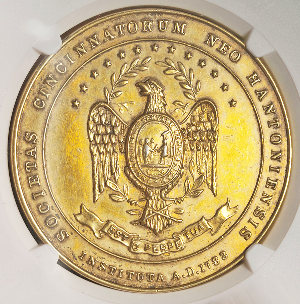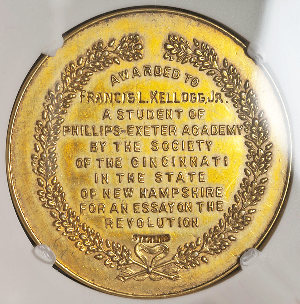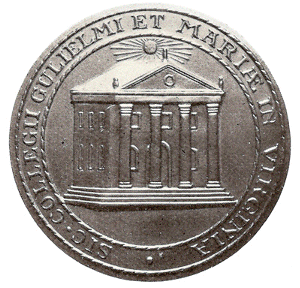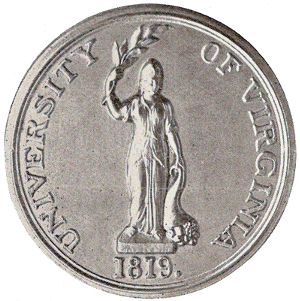The New Hampshire Society of the Cincinnati at the annual meeting held
Exeter on July 4, 1925:
"VOTED: That the Society donate annually a silver medal of the Society,
together with a suitable honorarium, to a student of the Phillips Exeter Academy to
be selected in competition on the basis of the best paper prepared on some
phase of the history of the Revolution, 1775-1783; ..."
Further details were left to a committee that was directed to confer with
the Principal of the Phillips Exeter Academy. At the meeting of the Standing
Committee of the Society on October 25th, of the same year, the honorarium
was established in the sum of $25.00 to be paid in gold. The meeting of the
Standing Committee of October 11, 1926, added the requirement that not less
than five students enter the contest and that a copy of the winning essay be
made available for the Society. The prize has been continued annually,
though present restrictions do not permit the honorarium to be paid in gold.
The title for the 1931-2 contest was restricted to the Yorktown Campaign.
The prize and medal are presented by the President of the Society on Prize
Day about the middle of June of each year.

Medal awarded annually at the
Phillips Exeter Academy
by the New
Hampshire Society of the Cincinnati.
This medal awarded c 1940. (Obverse). Hume #11.

Medal awarded annually at the
Phillips Exeter Academy
by the New
Hampshire Society of the Cincinnati.
This medal awarded c 1940. (Reverse). Hume #11.
The medal (Hume #11), is of the same size and has the same obverse as that above described (Hume #9) for the New Hampshire Cincinnati medal commemorative of the Triennial Meeting of the General Society of the Cincinnati at Exeter in 1920. It was, like its predecessor, struck by N. G. Wood & Son, of Boston. The reverse bears a wreath of oak leaves, in the center of which is the inscription: "Awarded to A Student of Phillips Exeter Academy by the Society of the Cincinnati in the State of New Hampshire For an Essay on the Revolution".
Phillips Exeter Academy (often called Exeter or PEA) is a highly selective, coeducational independent school for boarding and day students in grades 9 through 12, and offers a secondary postgraduate program. Located in Exeter, New Hampshire, it is one of the oldest secondary schools in the United States. Its history, influence, wealth, and academic reputation have made it one of the most prestigious boarding schools in the world.
Exeter is based on the Harkness education system, a conference format of student interaction with minimal teacher involvement. It has the largest endowment of any New England boarding school, which as of 2018 was valued at $1.3 billion. On January 25, 2019, William K. Rawson was appointed by the academy's trustees as the 16th Principal Instructor. He is the 4th alumnus of Exeter to serve as Principal Instructor, after Gideon Lane Soule (1838–1873), Harlan Amen (1895–1913), and William Saltonstall (1946–1963).
Phillips Exeter Academy has educated several generations of the New England establishment and prominent American politicians, but has introduced many programs to diversify the student population, including need-blind admission. In 2018, over 45% of students received financial aid from grants totaling over $22 million. The school has been historically highly selective, with an acceptance rate of 15% for the 2019–2020 school year, and approximately 30% of graduates attend an Ivy League university.
Management of the school's financial and physical resources is overseen by trustees drawn from alumni. Day-to-day operations are headed by a principal, who is appointed by the trustees. The faculty of the school are responsible for governing matters relating to student life, both in and out of the classroom. The school's first enrolled class counted 56 boys; in 1970, when the decision was made to implement co-education, there were 700 boys. The 2018 academic year saw enrollment at 1,096 students, with 883 boarding students and 213 day students. The student body is roughly equally split between boys and girls, who are housed in 25 single-sex and two mixed-sex dormitories. Each residence is supervised by a dormitory head selected from the faculty.
At a meeting of the Society of the Cincinnati in the State of Virginia on October 19, 1925, the Society adopted the recommendation of the Standing Committee that Cincinnati medals below (Hume #12 and Hume #13) be established at the College of William and Mary and at the University of Virginia. The Presidents of both institutions accepted the Society's offer, and the medals were struck in Paris by A. Bacqueville, of 5 Galerie Montpensier, from the designs of the Chairman of the Medal Committee, Edgar Erskine Hume. The medals are presented annually.

Medal awarded annually at the
College of William and Mary by the
Virginia Society of the Cincinnati
1925. (Reverse). Hume #12.

Medal awarded annually at the
University of Virginia by the Virginia Society of the Cincinnati
1925. (Reverse). Hume #13.
Above, the medals awarded annually at the College of William and Mary and at the University of Virginia by the Virginia Society of the Cincinnati, 1925. The obverse of the two medals is the same as that of the obverse of Yorktown Medal of 1931 (Hume #16). The reverses, here shown, are respectively the seals of the two institutions.
At the College of William and Mary the medal is awarded for outstanding work in the Department of History, particular attention being paid to the history of Virginia. At the University of Virginia the medal is given for the best essay in Virginia and Colonial History.
During the first two years of their existence the medals were struck in gold, but subsequently, with the approval of the two institutions, they have been struck in bronze and a cash prize of $100 in addition given to each recipient.
The medals measure 2-1/8 inches in diameter and are 3/16 inch in thickness. The two medals have the same obverse. It bears, in high relief, the Eagle of the Society of the Cincinnati, and surrounding it, separated from the Eagle by a twisted cord, is the legend: Presented by the Society of the Cincinnati in the State of Virginia. The reverses of the medals bear the seals of the respective institutions of learning. That for the College of William and Mary consists of a representation of the main building of the college with a sun in splendor above. The legend is: Sig. Collegii Guinean et Marić in Virginia. This building has an interesting history. Completed in 1697 from plans drawn by Sir Christopher Wren, the famed architect of St. Paul's Cathedral in London, it is the oldest college building in the United States.
The reverse of the University of Virginia medal bears a symbolical female figure standing on a pedestal, and bearing in her right hand a laurel branch and in the left hand the cornucopia of plenty. The inscription is: University of Virginia 1819.
Last Page | Next Page | Return to First Page
All Rights Reserved.
Legal & Privacy Notices
